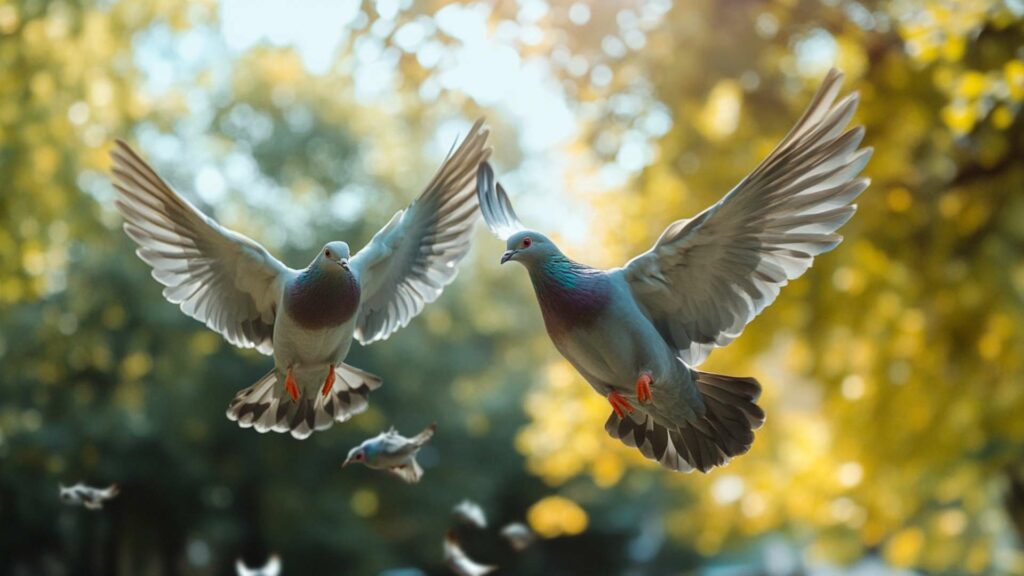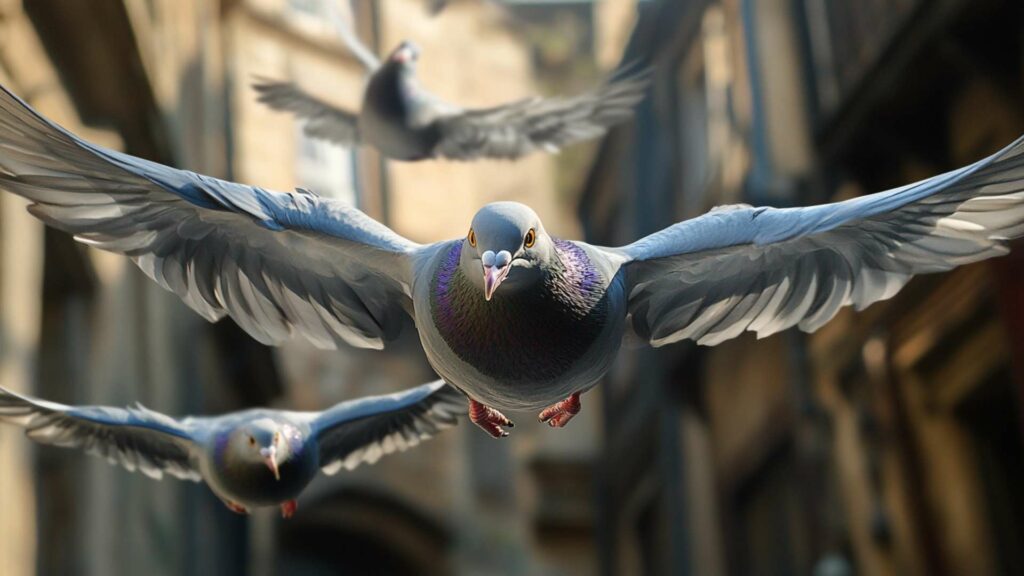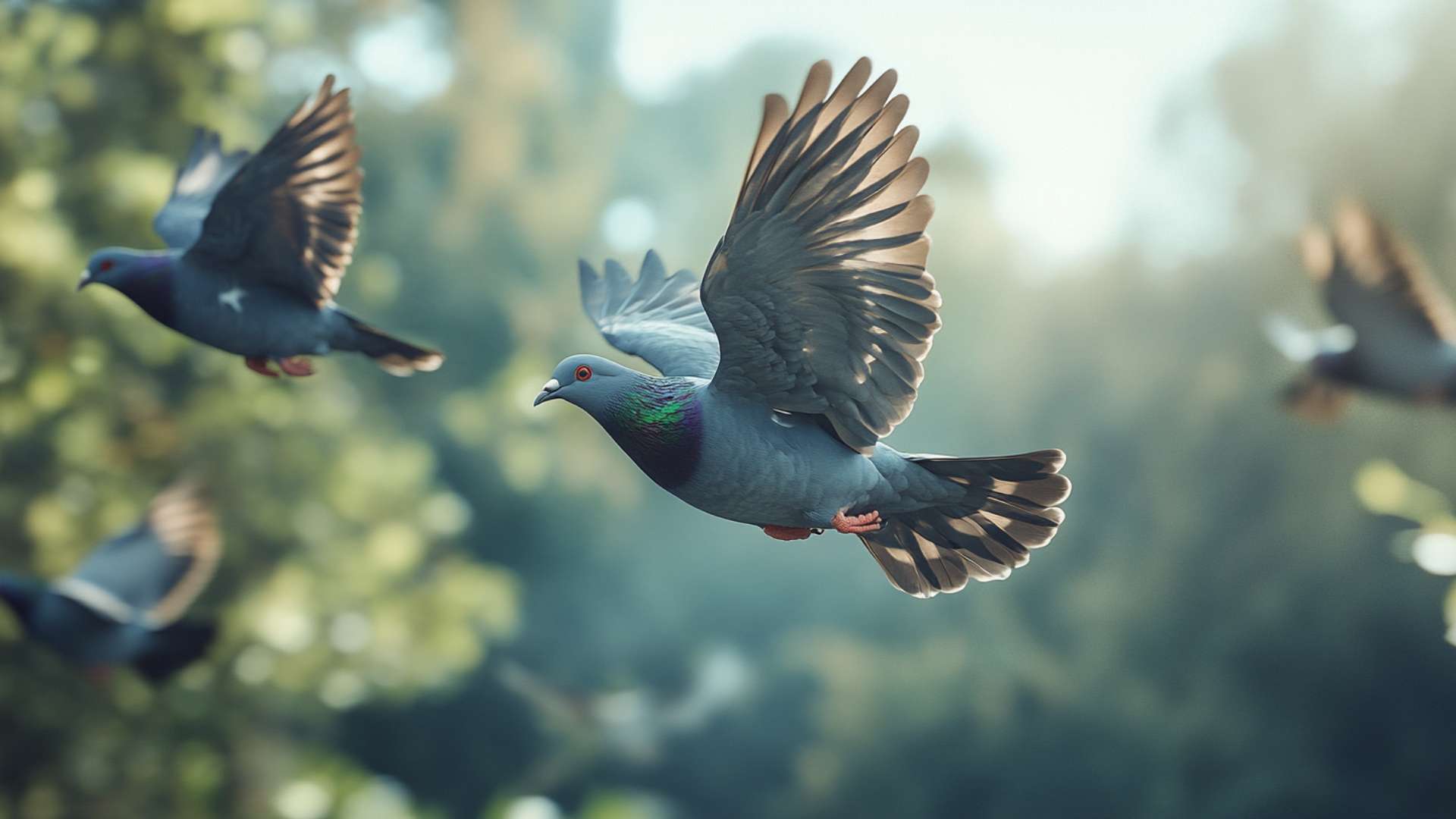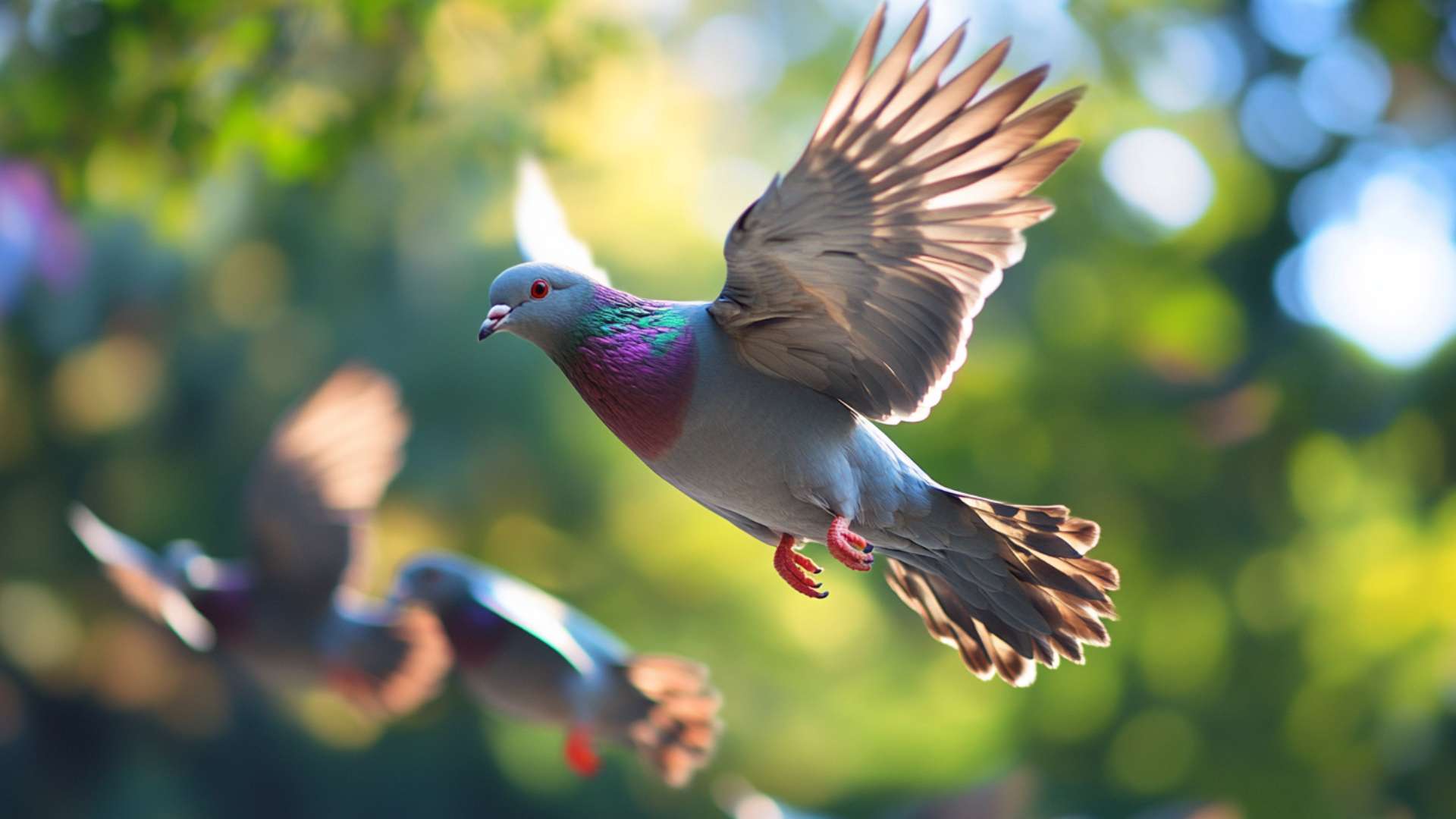Pigeons, those feathered friends that grace our city streets and park benches, belong to the Columbidae family. There are approximately 310 known species of pigeons, making them one of the most diverse bird families on Earth.
These avian creatures have been around for millions of years and can be found in various habitats across the globe. Pigeons come in an assortment of shapes, sizes, and colors, ranging from the vibrant hues of the Indian Blue Peacock Pigeon to the more common grayish plumage we often associate with pigeons.
Explore Our Professional Pigeon Control and Extermination Services! Uncover the effectiveness of our expert pigeon control and extermination solutions in addressing your pigeon-related concerns. Click here to learn more about our specialized pigeon control and extermination services!
Importance of pigeons in human history and culture

Throughout history, pigeons have made their mark on human civilization in remarkable ways. They have been appreciated for their beauty, utilized for their extraordinary abilities, and even worshipped as sacred symbols.
In ancient times, people admired pigeons for their elegance and domesticated them for various purposes. The ancient Egyptians valued pigeons so much that they even believed these birds had divine connections due to their ability to navigate vast distances.
Moreover, during times of conflict or urgent communication needs before telegraph or telephone systems existed, homing pigeons proved invaluable messengers. Soldiers often relied on these faithful birds to deliver critical messages across enemy lines with astonishing accuracy.
In fact, during World War I and II, brave carrier pigeons saved countless lives by carrying secret messages under perilous conditions. Similarly revered by different cultures worldwide throughout history – from Persia to Greece – it is no surprise that these fascinating creatures continue to capture our admiration today.
Can Pigeons Eat Rice?
Wondering if rice is safe for pigeons to consume? Learn about what pigeons can and cannot eat, including the facts about feeding them rice. For a comprehensive guide on the dietary habits of pigeons, check out our article on Can Pigeons Eat Rice?
Can Pigeons Eat Chocolate?
Discover the risks associated with feeding chocolate to pigeons and why it’s generally not recommended. To ensure the well-being of these birds and understand their dietary needs better, read more about it in our article on Can Pigeons Eat Chocolate?
Can Pigeons Swim?
Have you ever wondered if pigeons can swim? Find out more about their abilities in water and how they handle aquatic environments. For a deeper dive into the world of pigeons and their swimming habits, visit our article on Can Pigeons Swim?
Can Pigeons and Doves Mate?
Curious about the possibilities of pigeons and doves mating? Learn about their interactions and whether hybrid offspring can result from these encounters. For a detailed exploration of this intriguing topic, read our article on Can Pigeons and Doves Mate?
Can Pigeons Survive Cold Weather?
Find out how pigeons adapt to cold weather conditions and the challenges they may face during winter months. To gain a better understanding of pigeons’ resilience in cold climates, delve into our article on Can Pigeons Survive Cold Weather?
Can Pigeons Be Pets?
Considering having a pigeon as a pet? Learn about the feasibility and responsibilities of keeping pigeons as companion animals. For a comprehensive guide on pigeons as pets, explore our article on Can Pigeons Be Pets?
Can You Potty Train a Pigeon?
Interested in training a pet pigeon to use a litter box or designated area for waste? Discover whether potty training pigeons is possible and how to go about it. For in-depth guidance on this topic, read our article on Can You Potty Train a Pigeon?
Can You Eat Pigeon Eggs?
Ever wondered about the culinary possibilities of pigeon eggs? Explore whether pigeon eggs are edible and their use in various cuisines. For a detailed look at pigeon eggs as food, check out our article on Can You Eat Pigeon Eggs?
Can Rats Eat Pigeons?
Learn about the interactions between rats and pigeons and whether rats pose a threat to pigeons. For a comprehensive overview of this topic, including the behavior of these creatures towards each other, read our article on Can Rats Eat Pigeons?
Anatomy of a Pigeon: Feathers, Beak, Wings, etc.
When it comes to the anatomy of pigeons, these elegant creatures possess a range of fascinating features. Let’s start with their feathers, which play a crucial role in flight and insulation.
Pigeons have both contour feathers that cover their body and flight feathers that provide lift during soaring and maneuvering. These feathers are intricately arranged to form the pigeon’s distinctive shape.
Next up is the beak, an essential tool for pigeons in their search for obtaining food. The beak is slightly curved and designed for pecking and nibbling on various sources of sustenance.
Their strong beaks allow them to crack open seeds or grains with ease. Additionally, pigeons have specialized wings that enable swift aerial movement.
Their wingspan can vary depending on the species but is typically around 25-30 centimeters. Let’s not forget about the charming tail plumage of pigeons.
The tail acts as a rudder during flight and helps with balance while perching on branches or ledges. It consists of long central tail feathers called rectrices that create an eye-catching display when spread out or fanned by the birds.
Pigeon Senses: Vision, Hearing, and Sense of Direction
Pigeons possess remarkable sensory abilities that contribute to their survival in diverse environments. Starting with vision, these birds have excellent eyesight due to their ability to detect a wide range of colors and perceive ultraviolet light beyond human capabilities. This enhanced vision helps them navigate through landscapes and identify potential predators or sources of food from afar.
In terms of hearing, pigeons rely on acute auditory perception to communicate with one another and detect potential threats or warnings in their surroundings. They can vocalize through cooing, which varies in tone and rhythm depending on the situation.
The ability to communicate effectively is crucial for pigeons during courtship rituals and establishing dominance within their flock. One of the most intriguing aspects of pigeon biology is their innate sense of direction.
As they soar through the skies, pigeons possess a remarkable homing instinct that allows them to navigate over long distances and return to their roosting spots. While the exact mechanisms behind this ability are still debated, it is believed that pigeons utilize a combination of visual landmarks, magnetic fields, and even olfactory cues to find their way home.
Pigeon Communication: Cooing, Body Language, and Courtship Rituals
When it comes to communication, pigeons have developed a sophisticated repertoire of signals and displays. One of the most recognizable forms of pigeon communication is cooing. This soft melodic sound serves multiple purposes: expressing contentment or attraction during courtship rituals, signaling danger or aggression among rival males vying for territory or mates.
In addition to vocalizations, body language plays a crucial role in pigeon communication. Puffing out their chest feathers or strutting with an erect posture signify dominance or readiness to mate.
Conversely, cowering with fluffed feathers indicates submission or fear. Courtship rituals among pigeons are both fascinating and intricate affairs.
Males often engage in elaborate displays such as bowing, nodding their heads vigorously while cooing loudly, or puffing up their throats to impress potential mates. These striking behaviors not only demonstrate strength but also signal reproductive fitness.
Pigeon Intelligence and Problem-Solving Abilities
Contrary to popular belief, pigeons are highly intelligent creatures capable of complex problem-solving tasks. Numerous studies have revealed their cognitive prowess and adaptability in various settings. Pigeons have been trained to recognize and categorize objects, numbers, and even distinguish between different artistic styles.
Their ability to memorize locations and navigate intricate mazes is further evidence of their mental prowess. Pigeons are quick learners, displaying the ability to associate certain actions with rewards, which enables them to adapt their behavior accordingly.
Furthermore, pigeons possess a remarkable memory that allows them to remember familiar landmarks or routes. This cognitive prowess contributes to their homing instincts and helps them find their way back home across vast distances.
Pigeons possess an array of remarkable biological features and sophisticated communication abilities. From their intricate feathers, beaks, and wings that facilitate flight to their extraordinary senses of vision, hearing, and direction – these birds are truly fascinating creatures.
Additionally, the various forms of pigeon communication through cooing, body language, and courtship rituals showcase their social complexity within flocks. The intelligence and problem-solving abilities exhibited by pigeons demonstrate a level of cognitive sophistication that continues to captivate researchers worldwide.
Courtship Displays and Mate Selection in Pigeons

When it comes to romance, pigeons have their own unique way of wooing their potential partners. Courtship displays among pigeons often involve elaborate dances, gentle cooing sounds, and striking visual displays.
The male pigeon takes the lead in these performances, puffing up its chest feathers and strutting around the female with an air of confidence. This display is not only for show but also a way for the male to showcase its vitality and fertility.
Mate selection in pigeons is a fascinating process. Both males and females seek partners with desirable traits such as attractive plumage and overall health.
Once a pair has formed a mutual attraction, they engage in courtship feeding rituals where the male presents food to his potential mate as a gesture of affection. This act not only strengthens the bond between them but also serves as a demonstration of the male’s ability to provide for his future family.
Nest Building Habits of Pigeons

Pigeons are meticulous builders when it comes to constructing their nests. They use various materials they can find in their environment such as twigs, leaves, grass, and even bits of garbage or string that they stumble upon during their wanderings through urban areas or natural habitats alike. Unlike many other birds that build nests high up in trees, pigeons prefer to create their homes on ledges or protected areas like building eaves or rocky cliffs.
The female pigeon takes an active role in nest building while her partner assists by collecting materials or guarding against potential predators. The nest provides a safe haven for both parents-to-be and future chicks from harsh weather conditions as well as predators like larger birds who might see them as an easy meal.
Egg-laying Process and Incubation Period
Once the nest is ready, the female pigeon lays one or two eggs. The eggs are typically white in color and are laid a couple of days apart. Pigeons have a unique reproductive system where both parents share the responsibility of incubating the eggs. They take turns, usually switching every few hours, ensuring that the eggs receive warmth and proper care.
The incubation period for pigeon eggs lasts about 17 to 19 days. During this time, both parents diligently sit on the eggs, maintaining a constant temperature to ensure successful development.
The warmth provided by their bodies creates an environment suitable for hatching. It’s fascinating how pigeons can rotate their eggs using their beaks without accidentally damaging or eating them.
Parental Care and Feeding of Pigeon Chicks
Once the chicks hatch from their shells, they enter a world where their parents’ devoted care is crucial for survival. Pigeon chicks are born with yellowish down feathers covering their bodies until they grow adult plumage later on. The parents take turns feeding their young ones with a special substance called “pigeon milk.” This unique secretion is produced by both male and female parent pigeons in their crops (an expanded part of the esophagus used for food storage).
Unlike mammals producing milk from mammary glands, pigeons produce this sweet, highly nutritious liquid in response to hormonal changes during parenthood. This remarkable adaptation allows them to provide vital nutrients to their chicks until they are old enough to consume solid foods.
As the chicks grow older, they become more independent but still rely on parental guidance for learning essential skills like flying and finding food. Pigeon breeding and reproduction present us with an awe-inspiring display of natural instincts and nurturing behavior, reminding us that these seemingly ordinary birds are capable of extraordinary acts of love and care for their offspring.
Urban Pigeons vs. Wild Pigeons
Urban environments have presented pigeons with a unique set of challenges, but these resilient birds have managed to adapt remarkably well. One notable adaptation is their diet preferences.
While wild pigeons primarily forage for seeds, grains, and fruits in their natural habitats, urban pigeons have become expert scavengers. They take advantage of the abundance of food discarded by humans – from half-eaten sandwiches and pizza crusts to leftover hot french fries and crumbs on city sidewalks.
This scavenging behavior has allowed them to survive and thrive in densely populated areas where food sources are readily available. Another adaptation that sets urban pigeons apart is their nesting habits.
In the wild, pigeons typically build nests on cliffs or among trees using sticks and twigs. However, in cities where tall buildings dominate the skyline, urban pigeons have found a new home among the concrete structures.
They cleverly utilize ledges, balconies, and even air conditioning units as makeshift nest sites. This proximity to human dwellings offers them protection from predators while providing easy access to sheltered nesting spots.
Interactions with Humans: Feeding Habits and Behavior
Pigeons have developed a complex relationship with dogs and humans over centuries of cohabitation in urban areas. One significant aspect of this relationship lies in their feeding habits and behavior.
Park benches and plazas often become impromptu pigeon dining halls as people generously feed them with bread crumbs or birdseed. This regular feeding has conditioned urban pigeons to associate humans with a source of food.
Interestingly, this dependency on human-provided food has influenced changes in pigeon behavior as well. When fed by hand or from a designated spot, pigeons learn to gather around these “feeding hotspots” at specific times, forming large flocks.
These congregations not only create a spectacle for onlookers but also serve as a social gathering for the birds themselves. Pigeons communicate with each other through various vocalizations and body language, exchanging information about food sources and potential threats.
Differences in Survival Rates between Urban and Wild Populations
While it may seem that urban pigeons have it easy compared to their wild counterparts, there are distinct differences in the survival rates between these two populations. Predation plays a crucial role in shaping these survival and death rates.
In the wild, pigeons face predators such as raptors, cats, and other animals that target them both on the ground and in flight. This constant risk of predation acts as a natural selection mechanism that favors individuals with superior evasion skills.
In contrast, urban pigeons are relatively safe from natural predators due to their adaptation to city environments. However, they face different challenges related to human activity.
Pigeon droppings can accumulate on buildings and pose health risks if not regularly cleaned. Additionally, urban living often exposes pigeons to eat an overabundance of food high in fat and low in nutrients, leading to potential health issues for some individuals.
Urban pigeons have made impressive adaptations to thrive amidst concrete jungles by scavenging for food and nesting among tall buildings. Their interactions with humans have shaped their behavior patterns while altering the dynamics of their social structure.
Nonetheless, pros and cons exist when comparing the survival rates of urban pigeons versus those of their wild counterparts who face ongoing predation pressures but benefit from a more balanced diet. Understanding these differences sheds light on how many pigeons may have successfully carved out niches within our human-dominated habitats while coexisting alongside us.
The Homing Instinct of Pigeons
Historical use of homing pigeons for communication purposes
Throughout history, pigeons have played a remarkable role in long-distance communication. They were used as messengers to carry important information across great distances.
The ancient Egyptians, Greeks, and Romans all recognized the astonishing ability of pigeons to return to their home base from unfamiliar locations. In fact, during times of war or siege, homing pigeons were relied upon to deliver messages quickly and safely.
Theories behind the homing ability: Magnetoreception, Olfaction, Visual cues
Scientists have proposed several theories to explain how homing pigeons navigate their way back home with such precision. One prominent theory is magnetoreception, which suggests that pigeons possess the ability to sense Earth’s magnetic field. This internal compass allows them to maintain a consistent heading even in unfamiliar territory.
Another theory revolves around olfaction—the sense of smell—as a primary means of navigation for pigeons. Pigeons have an exceptionally keen sense of smell and can detect scent particles in the air with incredible accuracy.
By following scented trails or memorizing specific odors along their journey, they are able to find their way back. Additionally, visual cues play a significant role in pigeon navigation.
Pigeons rely on landmarks or celestial bodies such as the sun or stars to guide them along their path. They are known for their exceptional visual memory and can recognize familiar landscapes from great distances.
Pioneering studies on pigeon navigation
Numerous scientific studies have been conducted over the years in an attempt to unravel the mysteries behind pigeon navigation abilities. One notable study involved placing magnets on pigeons’ heads and observing how it affected their navigational skills.
The researchers discovered that when the magnets interfered with the magnetic field around them, the pigeons became disoriented and lost their way. This provided evidence supporting the magnetoreception theory.
Another study focused on disrupting pigeons’ sense of smell by blocking their nasal passages with various substances. The results showed that when their sense of smell was suppressed, the pigeons struggled to find their way home, further confirming the importance of olfaction in navigation.
Researchers have also used GPS tracking devices to monitor pigeon flights. These studies revealed that pigeons tend to follow specific flight paths, often taking advantage of natural landmarks or geographical features to fly over.
By analyzing their flight patterns and behaviors, scientists continue to gain insights into how these incredible birds navigate over long distances. Homing pigeons’ ability to find their way back home has fascinated humans for centuries.
Theories involving magnetoreception, olfaction, and visual cues have shed light on this remarkable skill. Pioneering studies have provided valuable insights into how pigeons navigate, uncovering some of nature’s secrets as we marvel at these feathered navigators’ extraordinary abilities.
Peculiarities about Specific Types of Pigeons: Fancy Pigeons
Feathers that Dazzle the Senses
When it comes to flamboyance, fancy pigeons take the crown. These birds have been selectively bred for specific traits, resulting in a stunning array of feather patterns and colors that can make your eyes twinkle with delight.
From beautifully laced feathers to extravagant crests and feathered feet, fancy pigeons are a living masterpiece. The diversity is astonishing, with breeds like Fantails boasting elegant fan-shaped tails and Jacobins parading ruffled neck feathers reminiscent of regal collars.
Breeding Beauty and Elegance
To achieve such exquisite appearances, pigeon breeders have dedicated their time and expertise in fine-tuning desired features. Breeding fancy pigeons involves meticulous pairings based on individual characteristics to produce offspring that meet specific breed standards.
This process ensures that future generations continue to possess the dazzling charm of their predecessors. From choosing pairs with desirable color combinations to emphasizing certain physical traits, pigeon fanciers carefully curate each generation while ensuring the health and well-being of their birds.
A Unique Connection with Humans
Fancy pigeons are more than just eye-catching birds; they have formed a special bond with humans over centuries. Their striking appearance has made them popular as exhibition birds in competitions worldwide. These events gather enthusiasts who appreciate the various breeds’ distinct qualities, competing for honors like “Best in Show” or “Champion Fancy Pigeon.” The beauty and elegance showcased by these pigeons often evoke awe-inspiring emotions among spectators.
Conclusion
In this journey through pigeon-related questions and curiosities, we’ve explored the fascinating world of these remarkable birds. From their biology and behavior to their breeding practices and peculiarities like fancy pigeons, it’s clear that pigeons are more than just city-dwelling pests.
They are intelligent, adaptable creatures capable of forming unique connections with humans. Next time you spot a flock of pigeons basking in the sun or strutting around an outdoor aviary, take a moment to appreciate their beauty and resilience.
Pigeons have played significant roles throughout history and continue to capture our imagination. Whether they serve as messengers or companions, pigeons remind us of the interconnectedness between humans and animals.
So let’s celebrate these remarkable birds, for they bring joy to our lives through their vibrant plumage, graceful movements, and unwavering spirit. Just as we care for our indoor birds in a lovingly crafted cage or provide a healthy environment for pigeons in an outdoor aviary, let us cherish the diversity and wonder of nature’s creations.
Frequently Asked Questions:
Pigeons have excellent navigation skills, can fly long distances, mate for life, are found worldwide, and have been used for messaging.
Pigeons are unique for their homing abilities, versatile diet, and historical roles.
Pigeon post was a postal system using pigeons as messengers, notably used during wartime.
The term “pigeon” has origins in Old French and Latin words, referring to young birds or chicks.








